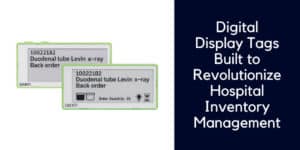What’s inside:
The aim of any healthcare supply chain strategy is very simple – it’s getting the right products, to the right place, at the right time. In reality, it’s not so easy, as healthcare providers are battling against:
- Regular supply chain disruptions
- Unpredictable patient volumes
- Inadequate supply chain data
- Rising inflation, negative margins and cost-cutting drives
This blog will look at some of these issues and discuss how supply chain technology can help healthcare organizations to optimize supply chain management.
Get used to it, supply chain disruptions here to stay
There is a tendency to associate supply chain disruptions with COVID 19. Certainly, this topic became a priority during the pandemic, prompting healthcare leadership to better understand the role played by the supply chain in the delivery of high-quality patient care.
The extreme supply chain disruptions of 2021 shone a spotlight on the supply chain in hospitals and ambulatory surgery centers, prompting increased investment an renewed will to future-proof and optimize healthcare supply chain management.
There is a growing understanding that healthcare providers will need to anticipate ongoing supply chain disruptions, due to ongoing global issues such as future local or worldwide pandemics, natural disasters, economic crises, materials shortages and more. Healthcare supply chain disruptions will likely become a regular challenge, and those healthcare organizations that learn to how to navigate this ‘new normal’ are likely to manage much better than those that are ill-prepared.
Bottlenecks in the supply chain now need to be expected and navigated. Today’s healthcare leadership is looking at resilience-building measures that add flexibility and agility to the hospital supply chain.
It will be those organizations that modernize their supply chain that set themselves up for growth.
Supply chain cost-saving initiatives are in fashion
The difficult economic climate, in particular rising inflation and staffing costs, have led to spiraling supply costs.
- The American Hospital Association (AMA) reported that supply chain expenses per patient increased by 18% between 2019 and 2022, with supply chain costs rising by 33% during the same period. *1
- Labor shortages, escalating wages and increased reliance on contract labor have been major challenges for healthcare providers. The AMA reported that temporary labor costs rose a staggering 257.9% between 2019 and 2022. A significant element of this is due to contract staffing agencies adding an admin fee of up to 60% to their charges. *2
Rising labor costs and increased expenditure on drugs and medical inventory are difficult for hospitals to control. In order to make the figures add up, healthcare providers are turning to cost-control initiatives in a bid to counteract the financial pressures, while taking care to ensure high levels of patient care.

Responding to inefficiencies and negative margins
Many supply chain processes involve repetitive, routine and manual activities which have great potential to be reviewed, modernized and improved. In addition, there are often inadequate data outputs from current systems, and this can be the root cause of many inefficient practices.
Healthcare supply chain cost management has the potential to make significant costs savings and may include:
- Researching and expanding the supplier base
- Reviewing vendor contracts
- Gaining a better understanding of current and future needs
- Cutting waste
- Streamlining the inventory
- Standardizing physician preference items (PPI)
- Reducing reliance on just-in-time inventory
- Simplifying systems, processes and workflows
- Improving supply chain technology
- Gaining improved inventory visibility
- Building greater internal collaboration
These are just a few key areas and each has the power to add efficiency, as well as drive through cost savings.
As we have mentioned, one common success factor is having full and accurate data to support more informed decision-making. There’s often a history of underinvestment in supply chain technology and many hospitals, in particular smaller, rural providers, are still using manual systems.
Lack of data results in lack of vision.
There’s a definite need to break the cycle in order to reduce costs and
add efficiencies into the healthcare supply chain.
Outdated inventory management systems and incomplete data sets
There is great potential to revolutionize supply chain management in many healthcare organizations.
There are plenty of providers who have ‘settled’ for inefficient healthcare inventory management systems which:
- Rely on manual inventory rounds to monitor stock levels.
- Require the manual keying in of usage data into 2 or 3 separate systems.
- Create ‘best guess’ restock orders due to lack of reliable data
- Lead to high levels of product wastage
- Use outdated technology, which is reliant upon an up-to-date Item Master
- Fail to provide accurate visibility, tracking and usage data.
- Produce incomplete charge capture and surgical records.
- Create data silos that prevent easy access to vital data by internal or external stakeholders.
This way of working is inefficient on several fronts:
- Labor intensive
- Costly
- Inaccurate
- Prone to stockouts and surpluses
- Wasteful
Although there is widespread recognition that supply chain automation and data analytics are a key element of cost-cutting initiatives and supply chain upgrades, it can still be hard to gain approval for digital supply chain solutions.
But it needn’t be this way.

The urgent need for accurate supply chain data
Purchasing supply chain technology is an investment that pays off.
Data is recognized as a valuable tool for providing:
- Real-time inventory vision
- End-to-end tracking and
- Consumption data
- Management analytics
- Improved business efficiency and cost savings
As long as full and accurate data is obtained via automated data sensing tools, then meaningful data analytics can be produced that provide a valuable steer for decision-making.
A RevCycle Intelligence article highlighted how the use of data analytics has the potential to reduce costs and automate processes, which could create savings of almost 18%.*3
Good practice tells us that it’s not just necessary to collect this data, but to share it with internal and external supply chain stakeholders. One key feature of automated inventory management systems is that they should be able to both collect full and accurate data across the supply chain, and then swiftly share it with hospital systems so that it can be used for key operational activities. In addition, many systems facilitate third party access to supply chain data to facilitate shared vision.
Supply chain automation, and the resulting data, are the lifeblood of the modern healthcare organization. The right automated SCM system can simplify workflows and provide supply chain information that helps management to make informed decisions relating to people, processes and products.
People
- Technology can reduce the supply chain burden on nurses, freeing them up to nurse and improving job satisfaction.
- Stock visibility makes it easy to locate items needed, saving time and frustration.
- Logistics activity can be automated, saving time and manpower, and improving the accuracy of inventory data.
- Physicians can be involved and empowered in the supply chain and can contribute to key discussions such the importance of variance analysis in healthcare.
Processes
- Streamlined workflows save time and add efficiency into supply chain management.
- Item Master data management and maintenance.
- Automated tools add speed and accuracy to the collection of supply chain data.
- Automated procurement prevents stockouts and surpluses.
- Efficient workflows reduce wastage, lower costs and improve operations.
- Data is a patient safety issue and helps prevent ‘never events’ in healthcare, and to handle product recalls.
Products
- Automation supports efficient expiry and recall management, reducing wastage and safeguarding patients.
- Achieve a streamlined inventory based on accurate stock and usage data.
- Reduced stock levels free up storage space.
- Accurate data helps forecasting, for improved inventory planning.
Facilitating improved supply chain collaboration
Internal stakeholders: There is fresh desire within healthcare leadership to improve internal supply chain collaboration. Organizational silos are breaking down and a clinician-lead supply chain is starting to take shape. Increasingly multi-disciplinary decisions are taking place, such as the value analysis of new products and discussion of purchasing plans.
A recent McKinsey poll *4 found the following:
“In high-performing organizations, clinicians play an integral role in supply chain initiatives: They provide input on supplier selection and contracting strategies, including their financial impact; they support compliance with contract terms (for example, by committing to give a supplier a negotiated share of business); they manage the use of supplies; and they otherwise contribute to achieving financial, quality, or other goals.”
External stakeholders: It needs to be noted though, that health systems, hospitals and ambulatory healthcare service providers are but one stakeholder in a supply chain that also includes vendors, distributors, insurance companies, group purchasing organizations etc.
One way to tackle supply chain vulnerabilities is to work closely with stakeholders, and technology is playing a key role in bringing synergy and shared vision among key players in the healthcare supply chain.
Many forward-thinking healthcare providers are now using technology that:
- Provides real-time inventory vision to selected supply chain partners
- Automates purchase requisitions based on identified need
- Supports enhanced stock monitoring and control, to prevent wastage
Increased trust and transparency can build a clinically integrated supply chain, and stronger stakeholder relationships which open the door to enhanced contractual arrangements.

Technology cannot just be a ‘tag-on’ for failing processes
Technology and data are central to the modernization of the healthcare supply chain, but it can’t be expected to work in isolation.
Organizations need to:
- Have a thorough understanding of how they manage their supply chain, what works and what doesn’t.
- Review job roles, tasks, processes, systems, healthcare supply chain software and tools.
- Gain an understanding of potential supply chain optimizers that could make a significant impact on the efficiency of their inventory management.
According to a recent Deloittes article *5 supply chain resilience is built by addressing the root causes of supply chain inefficiency and using technology as the enabler:
“Although technology is a crucial enabler of resilience through supply chain digitalization, using it as the tip of the spear to address supply chain weaknesses may only partially fix the issue. Comprehensive solutions that position technology as a component alongside people and processes can help make health care supply chains more resilient.”
Today’s healthcare supply chain is taking on more strategic importance and the upgrade of systems, processes and tools aims to improve efficiencies, meet new performance targets and drive through bottom-line savings.
Supply chain data analytics
Data is the foundation of supply chain optimization, yet it remains a critical gap for many health systems. In the Mckinsey poll a quarter of health system executives and supply chain leaders selected data and analytics capabilities as their number-one investment opportunity on their journey towards supply chain excellence.
Powerful supply chain analytics require the best data sensing tools that can operate in the challenging surgical environment. Complete implant tracking, from enrollment through to consumption, requires advanced digital tools that provide full, complete and real-time healthcare supply chain metrics.
IDENTI Medical uses a range of technology, such as RFID, image recognition, AI and machine learning, to create innovate supply chain solutions that work in the complex OR and procedure room setting. It’s the combination of smart, digital data collection tools, AI cloud software and shareable data analytics that make IDENTI’s solutions so easy to implement, and so quick to benefit from.
Contact us to find out how our tools can help you optimize your healthcare supply chain.
- *1 Costs of Caring | AHA
- *2 AHA Q2_Feb 2023.pdf (syntellis.com)
- *3 Data Analytics Add Value to Healthcare Supply Chain Management (revcycleintelligence.com)
- *4 Optimizing the healthcare supply chain | McKinsey
- *5 Health care supply chain resilience | Deloitte Insights






